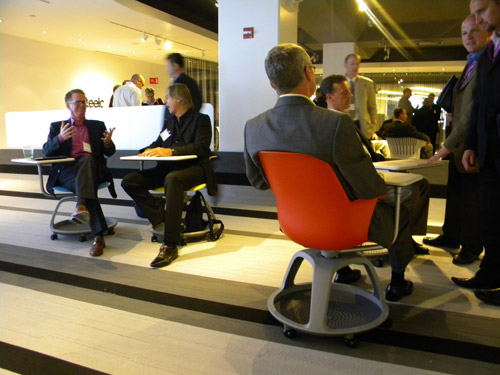Furniture Tips for College and University Facilities: Part One
Have you ever thought about your furniture setup, whether it’s at your office, in a classroom, or in a public place, like a library or city hall? Ever thought about who picked out the chair you’re sitting in or the fabric it’s made of, or who designed your storage options? Honestly, I truthfully hadn’t until I met with LPA Furniture Guru Jill Kramer. I was on a mission to learn more about furniture, furniture setups, colors and fabrics specially designed for classrooms and Higher Education facilities. Enjoy these brief, informative responses, and feel free to submit questions at the bottom of the page.
 Jill Kramer, IIDA, LEED AP ID+C
Jill Kramer, IIDA, LEED AP ID+C
Q. Jill, can you give us a brief rundown of the furniture you’re using, this minute, in offices and classrooms for college and university facilities?
A. For administrative spaces, we use a blend of systems furniture and furniture made of hard materials. The spaces vary from single-person offices to shared offices, as well as touchdown or hoteling spaces for part-time faculty. Faculty layouts are often driven by their storage requirements. A new trend is storage towers, as well as low storage adjacent and below work surfaces, in both private offices and workstations. Panel heights are coming down to allow natural daylight in, too. With guidelines driven by LEED and good sustainable design practices, we are eliminating or reducing the use of panel mounted overhead storage. Instead, we’re opting for storage towers and desk lamps. Getting clients to be open to the concept of lowering panel and partition heights—to allow more daylight in—is a huge step. Users are accustomed to taller panels and the fear is that they will experience a louder working environment if panel heights are lowered. I’ve found, in fact, it’s quieter. The light is better, and increased, easy collaboration, is a bonus.
 For classrooms, our clients are requesting freestanding moveable tables, sometimes two-person or even single-person tables, which allow them to transition effortlessly into those collaborative groups. For a project I’m working on now, we’re playing around with the idea of the Steelcase Node chair. Students can put their book bags underneath these chairs, they also turn to allow students to work together and have conversations. The collaborative classroom environment is used with and without tables, which allows for a more flexible classroom. They do tend to take up a little more space meaning, seat count may be reduced. However, interactive learning environments coupled with intuitive technology are an unbeatable combination and instructors are definitely interested in these applications. There are some really informative and enlightening case studies and videos available, at 360steelcase.com.
For classrooms, our clients are requesting freestanding moveable tables, sometimes two-person or even single-person tables, which allow them to transition effortlessly into those collaborative groups. For a project I’m working on now, we’re playing around with the idea of the Steelcase Node chair. Students can put their book bags underneath these chairs, they also turn to allow students to work together and have conversations. The collaborative classroom environment is used with and without tables, which allows for a more flexible classroom. They do tend to take up a little more space meaning, seat count may be reduced. However, interactive learning environments coupled with intuitive technology are an unbeatable combination and instructors are definitely interested in these applications. There are some really informative and enlightening case studies and videos available, at 360steelcase.com.
Q. How are you incorporating technology into your furniture solutions for Higher Education facilities? How are you making it a more pleasant experience?
A. When it comes to integrating technology with classroom furniture, as an interior designer, I’ve been using desking solutions. Desking systems have longer table runs with fewer legs. Cabling lies either inside or underneath (i.e. Antenna Workspaces by Knoll), versus a typical computer table, where you’re working against cables and wires. Desking systems are easier for IT teams to work with and offer a cleaner look. Plus, they’re a big trend in today’s open office environments (i.e. Steelcase, Knoll, Herman Miller and other collaborative stand-up workstations).
For student unions, one of my favorite pieces has to be Allsteel’s credenza piece, with a white board on one side and a T.V. on the other. It’s really interesting because it’s all about flexibility and the credenza’s very functional. The release of Vitra’s AirShareit, is also something I’m really looking forward to. This tool allows students to share ideas freely, projecting content from their laptops directly onto walls, nearby—a brilliant incarnation of functionality and flexibility. In Part Two of this mini-feature, we'll delve into colors, fabrics, and ergonomics, for furniture solution in Higher Education facilities.
Jill Kramer, IIDA, LEED AP ID+C, has more than 14 years of experience in the contract furniture industry specifying more than $40 million. Her experience includes working for and with furniture dealerships, design firms and end users in furniture specification, procurement, ergonomics, needs assessment and full project management. She oversees Furniture Management Services at California-based LPA Inc., where she is also a Project Manager. Images Courtesy: Jill Kramer and Workspaces by Knoll.
HELPFUL LINKS
http://www.classroom-furniture.org/
http://college.emory.edu/home/assets/documents/facilities/classroomGuidelines.pdf
http://www.alibaba.com/showroom/college-classroom-furniture.html
http://www.bkmofficeworks.com/industry_solutions/higher_education.php
http://www.todaysclassroom.com/pages/Discount-Classroom-Furniture-Deals.html